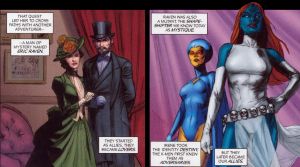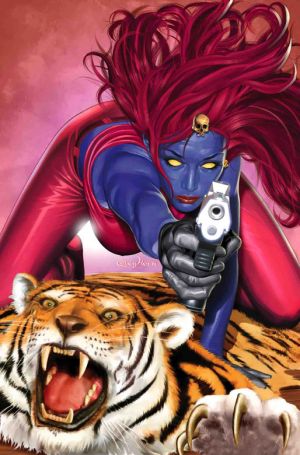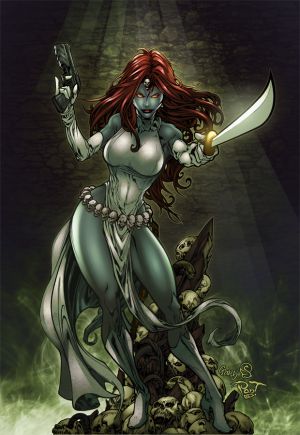Comics /
Spotlight /
Queer Comics
Mystique: Crossing the Boundaries of Sex, Gender and Human Nature
By
J. Skyler
August 23, 2012 - 12:08
The word “transgender” brings up different images for different people, primarily because the differences between gender identity, genetic sex and sexual orientation are often misunderstood. A lack of interest and/or involvement on the subject of gender identity (in addition to stereotyping) often leads to misconceptions about transgender people. According to the
American Psychological Association (APA), “[t]ransgender is an umbrella term for persons whose gender identity, gender expression, or behavior does not conform to that typically associated with the sex to which they were assigned at birth.” For decades, transgender individuals have been left in the background of civil rights efforts, the same way lesbian and bisexual women were left out of the conversation in the initial stages of the Gay Liberation in the 1960s. As Susan B. Marine notes in
Stonewall's Legacy: Bisexual, Gay, Lesbian, and Transgender Students in Higher Education: AEHE (2011), even in institutions of higher learning where students are actively seeking to better understand differing points of view and life experiences, simply adding the ‘T’ to LGBT programs “does little to combat the invisibility of transgender students’ specific needs.” One statement from
Stonewall's Legacy that is reflexive of the entire LGBT political and social movement is that “[w]e have the word transgender in our title, but we aren’t very good about including transgender themes in the things we do.” The world of fiction is no different. Despite an increased visibility of identifiable lesbian, gay and bisexual characters in the comic book industry, explicitly stated or self-described transgender characters continue to evade publication. Although depicted in a more ambiguous way, the shape-shifting Raven Darkhölme, otherwise known as Mystique—whose mutant ability allows her to shift between genetic sex—is an unspoken icon to the Transgender community.
Before we can understand her representation of trans-related issues, it is important to first separate sex from gender. Among sociologists, psychologists and medical professionals, the word sex is used to describe a person’s chromosomal make-up (XX for females, XY for males) and reproductive organs. Gender, however, implies psychology—the mannerisms, characteristics and behaviors which shape a person’s sense of manhood or womanhood—and the degree to which such attributes are dependent on biological factors or cultural influence. Secondly, we must separate sexual orientation from gender identity. Whether we are discussing heterosexuality, bisexuality or homosexuality, what defines sexual orientation is what sex a person is attracted to. Gender identity, however, reflects one’s inner sense of being male or female, regardless of their physical anatomy. When we discuss gender identity, sexual orientation is more or less irrelevant. Generally speaking, men—regardless of sexual orientation—typically develop a male gender identity, while women—again, regardless of sexual orientation—usually adopt a female gender identity. Even among gay, bisexual, or straight men who are comfortable expressing feminine characteristics, or lesbian, bisexual and straight women who possess masculine attributes, there is still a fundamental difference in exhibiting certain qualities and
seeing one’s self as literally being the opposite sex.
In classroom forums, or other public speaking venues where I am a panelist discussing LGBT culture politics and history, I usually introduce myself by stating that my name is Skyler and “I am transgender.” During the course of these panels, I typically get fielded the most questions in comparison to the other participants. Since people look at me and see a presumably “ordinary” male (aside from the fact that I love cosmetics), questions such as “what does that mean?”, “are you male or female?”, “have you had sex reassignment surgery?” are among the most frequently asked. My answer is usually as follows: “I am biologically male, meaning my chromosomal make-up is XY just as any other male, but my gender identity or psychological sense of self is female. I’ve been aware of my gender identity since my earliest memory at age 4. That being said, I have not had sex reassignment surgery and I have not undergone hormone replacement therapy.” Since SRS is the recommendation for gender dysphoric individuals (transsexual being a medical term specifically referring to those in the pre-operative, in-transition, or post-operative stage) the most common follow-up question is “are you planning to transition in the future?” The simple answer is no for a multitude of reason, but primarily because of the fact that surgery (of any kind) terrifies me to no end. I’ve often joked that the only way anyone would be able to get me into the ER after an accident is if I were instantly knocked unconscious, but that’s more a matter of fact than an exaggeration (it’s ok to laugh about it, I do quite frequently).
In the book
Biology of Human Reproduction (2002), author Ramón Piñón states that “[f]or nontranssexuals, the discordance between gender identity and anatomy is impossible to conceive… The transsexual does not deny her or her anatomy; rather the anatomy is the source of psychic pain. The discordance has varying degrees of intensity, ranging from mild dissatisfaction and vague sense of unease (a sense of being trapped in the wrong body) to a pronounced dislike, even loathing, for one’s body, particularly its sexual characteristics.” Personally, I loathe having a penis, as well as other male characteristics (for the anatomical females reading this, picture for a moment what it would be like for you to wake up with a full beard and having to shave your face), but the idea of reconstructive surgery—for me—is unappealing; I don’t believe I would be able to walk away from it without a sense of dissatisfaction, despite my discordance. However, most individuals who opt for SRS are perfectly happy with genital reconstruction, and in fact, lead much psychologically healthier lives after their transition. The choice to transition or not will vary from person to person—therefore, my own personal experience should not be taken as being uniform for all gender-variant people.

|
A fear of surgery—or more precisely, a fear of an irrevocable decision such as reconstructive surgery—is what part of what initially drew me to Mystique’s character, despite my reluctance to identify with a villain. As a child, even though I dreamed of being the genteel telepathic and telekinetic Jean Grey, the youthful and vibrant Jubilee, or the African weather goddess Storm, the villainous Mystique’s ability to shape-shift was too alluring for a transgender child to ignore. At age 6, I attempted to tell my mother that I wanted to be a girl. Suffice it to say, it didn’t go over well. I had always known I was different, but that was the first time I realized being different was a “bad” thing. The idea of possessing Mystique’s shape-shifting powers gave me a much needed escapism: the fantasy of being able to change from male to female at will, when such a transformation could suit my needs. It meant being able to spend part of the time as the person everyone expected me to be, but would also allow me to be the person I wanted to be. In my fantasy, there were no ultimatums and I didn’t have to choose between one extreme over the over. I would imagine there are a number of transgender/transsexual individuals who, in contrast, would appreciate possessing Mystique’s capability to effortlessly transition into the opposite sex and never look back.
Being a girl, and yet a boy, my affinity for Mystique led me to view her not only as an analogy for trans-identification, but for a more universal theme of gender non-conformity. Mystique was born female and possesses a female gender identity, but neither defines her. She is as comfortable adopting a masculine persona and living as a man as she is in her natural form—an atypical mindset in a world where sex and gender so rigidly define all cultures and our perception of one another. Most people believe that as human beings, we are divided into being exclusively masculine or feminine. In the article “The Measurement of Psychological Androgyny” by Sandra L. Bem in the
Journal of Consulting and Clinical Psychology (1974), the author writes that “[i]n general, masculinity has been associated with an instrumental orientation, a cognitive focus on ‘getting the job done’; and femininity has been associated with an expressive orientation, an affective concern for the welfare of others.” The reality is that while men may more frequently exhibit masculine traits (aggression, ambition, autocracy) and women may more typically express feminine characteristics (passivity, empathy, compassion) both sexes naturally possess each of these qualities to varying degrees. Thus, androgyny is an innate aspect of human psychology, regardless of sex, sexual orientation or gender identity. It isn’t feasible for a man to be in a
constant state of aggression any more than a woman can be in a
constant state of passivity. Rather, both men and women can “be both masculine and feminine, both assertive and yielding, both instrumental and expressive—depending on the situational appropriateness of these various behaviors[.]” Part of what makes Mystique such an effective character is her sense of fluidity, her mental capability to adapt to any situation as it arises. As the authors of
Handbook of Gender Research in Psychology, Volume 1 (2010) wrote, “[p]sychological androgyny can be understood as both stereotypically feminine and masculine characteristics. Androgynous individuals do not conform to expectations based on gender alone.” Mystique has no concern over what is deemed “appropriate” for a man or a woman, but she will utilize gender preference or stereotyping to manipulate those around her, taking advantage of any situation.
As vile as she can be, her character history does help to illustrate an important sociological fact: social and economic inequality breed criminal activity. Kathryn M. Neckerman, in
Social Inequality (2004), wrote that “[e]conomic inequality might influence the scale of punishment in two main ways. Rising inequality may increase crime at the bottom of the social hierarchy, generating more arrests, convictions, and prison admissions,” while
The Psychology of Criminal Conduct (2010) documents that “social and economic inequality—not personality or biological factors—are the most powerful predictors of predatory violent crime.” With a lifespan dating back at least to the 1930s, Mystique has seen nearly every civil rights movement that has shaped the country. As a woman and a mutant, she has suffered persecution supported by law. When the laws of a society work against its populous, people can either work to reform it or live outside of it; out of a sense of survival, Mystique has often chosen the latter. In the book
Supervillains and Philosophy: Sometimes, Evil is its Own Reward (2011), it is stated that as members of the Brotherhood of Evil Mutants, “both Mystique and Toad have noted that the name is meant to be ironic, at once showing both the group’s awareness of the general public’s disapproval of them and their disregard for public disapproval. Their appropriation of the name [taken from a newspaper headline] could easily be understood as the equivalent of a rude gesture to the world—‘So you think all mutants are evil? Well here we are, your ‘evil’ mutants.” Mystique’s status as an outcast—not only as an outcast, but as an outcast even among mutants for being a shape-shifter—only intensifies her connection to the transgender community. Transgender people have been vilified and demoralized at the hands of gay, lesbian and bisexual people as frequently as they have been by heterosexuals. Wishful thinking perpetuates the idea that the acronym LGBT means we are all one big happy family all over the world. However, it’s true that we can all be just as sexist, racist or bigoted as anyone else—mind boggling, but true.
Mystique’s villainy also illustrates a negative stereotype about transgender individuals: the idea that we are inherently deceptive and gain self-gratification out of "misdirecting" others. However, given the long history of transphobic violent crimes, including assault, rape and murder, concealing one’s birth sex as a matter of private medical history can be a matter of life or death depending on the situation. In
Violence, Victims, Justifications: Philosophical Approaches (2006), author Felix Ó Murchadha states that “a GenderPAC study in 1997 found that almost 60% of the participants had either been victims of trans-based violence or harassment, and 47% of the participants reported having been assaulted in some way over the course of their lives.” In a similar vein, Mystique has been depicted as leading multiple lives, hiding her status as mutant and in some cases, as a born-female. She has abandoned and adopted a number of identities after being “outed” in order to escape persecution. Had her environment been nurturing for those of a mutant background, and especially for shape-shifters, misdirection and concealment—and most importantly, criminal activity—would have been entirely unnecessary. Though Mystique cannot be absolved of all her sins, she does represent a tendency to blame the victim, even when the abused rise up against their abusers in a violent and militant fashion.
While her classification as a transgender character is understated, what has gained more universal acknowledgement is Mystique’s bisexuality. Since the now-defunct Comics Code Authority forbade any depiction of same-sex relationships, her sexual orientation could only be hinted at for a number of years.
The Supervillain Book: The Evil Side of Comics and Hollywood (2006) notes that “[h]er relationship with the blind precognitive mutant Destiny goes back at least to the 1930s. Though [writer Chris] Claremont did not make it explicit, he implied that Mystique and Destiny were lovers. In fact, in the 1930s Mystique adopted a male identity, ‘Mr. Raven,’ as Destiny’s companion.” Her sexual orientation also makes her an unprecedented bisexual icon, as bisexual people have also face persecution from gays and lesbians as frequently (and ironically) as transgender individuals. Bisexuals are often seen as being as equally “deceptive” as transgender people due to the fact that they are assumed to be incapable of monogamy. Moreover, the invisibility of her bisexuality epitomizes the concept of bisexual erasure—the assumption that bisexuality does not exist or the tendency to ignore the bisexuality identity of those known to have been in opposite and same-sex relationships by heterosexuals, as well as gays and lesbians alike.

|
In “The Bisexual Mystique” by Cheryl Ingro at afterellen.com, the author states that “X-Men writer and Mystique co-creator Chris Claremont has also since stated in interviews that it was his original intention that Mystique and Destiny be Nightcrawler's biological parents by way of Mystique having transformed into a man for conception. However, given Marvel's attitude at the time, the idea was considered entirely too controversial.” While most women would be disturbed at the idea of growing a penis and fathering a child, I would gather, given Mystique’s defiance of normative gender roles, that her commentary on the subject would be “… whatever.” Her capability to reproduce as a man or woman is somewhat analogous to true hermaphroditism—an extremely rare condition where an intersexed person is born with a penis, vagina, ovaries and testicular tissue (though only one set is fully functional). Mystique’s ability to experience the entire spectrum of the human condition makes her a rarity in fiction, while her willingness to open herself up to limitless possibilities is what has made her such an enduring character. It’s a bit euphoric that Mystique so adequately represents such severely underrepresented minorities, and yet, remains one of the most popular characters in American comics.
X-Men and Philosophy: Astonishing Insight and Uncanny Argument in the Mutant X-Verse (2009) observed that in spite of her bad reputation, “Mystique is probably the most human of all the X-Women in her behaviors, in her flaws and foibles, in her loves, in her losses, and in her life.” Perhaps one day, we’ll have a super hero rather than a super villain as a bisexual/transgender icon, but until that day comes, there is still a lot to be appreciated in the truly dynamic, gender-variant Mystique.
In honor of my 28th birthday, take a moment to listen to Lady Gaga’s “Hair” from
Born This Way, available on
VEVO!
Follow me on Twitter
@jskylerinc
Last Updated: November 29, 2025 - 16:51





